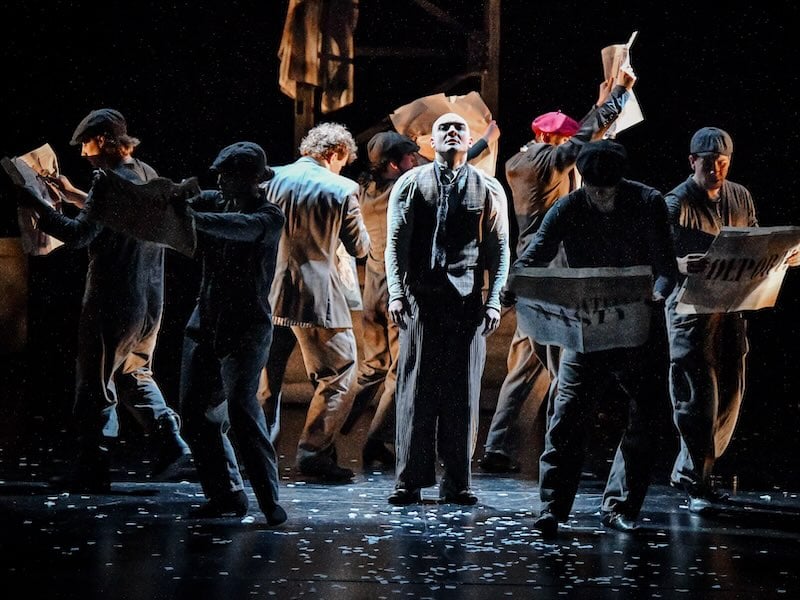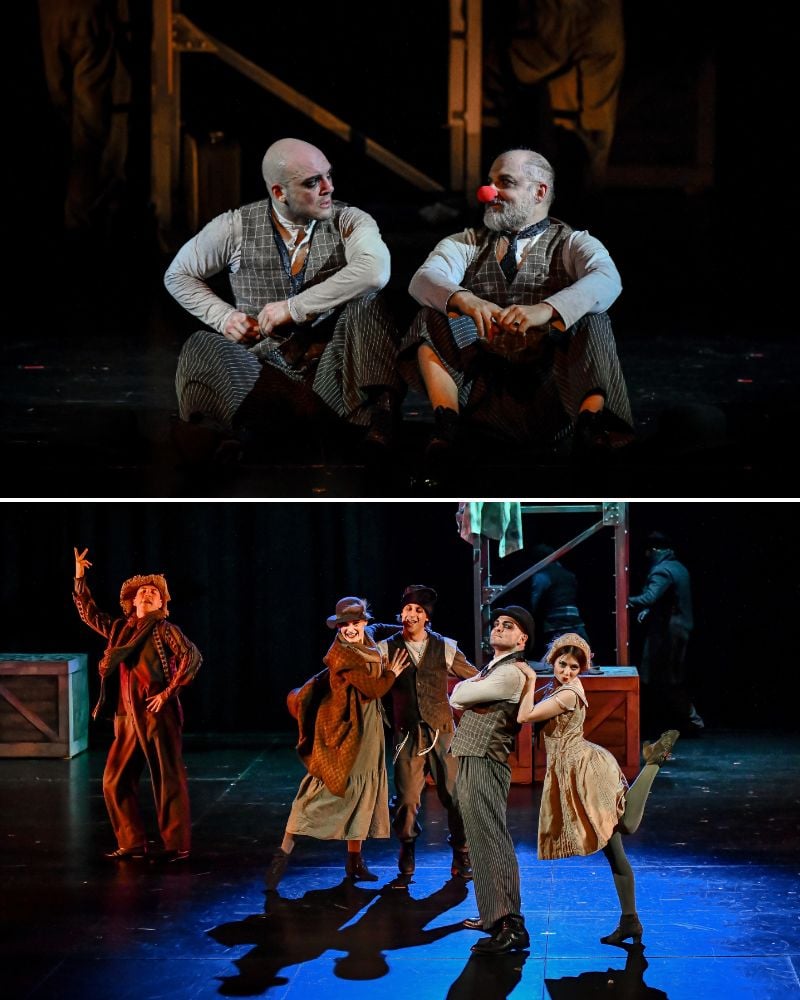Synetic Theater’s visually stunning, emotionally charged The Immigrant comes at a pivotal moment in our nation’s story, as well as that of the inimitable company itself. The production opens as one of the country’s largest immigrant deportation programs is underway, and numerous court battles are being fought over the mistaken deportation of some immigrants and the intended or accomplished deportation of others. For Synetic, the battles are personal: Its founders, Paata and Irina Tsikurishvili, emigrated to the U.S. from the former Soviet republic of Georgia in 1995. Since then, they have welcomed a number of émigré artists into their ranks. Moreover, The Immigrant, loosely adapted from the eponymous Charlie Chaplin silent film of 1917, marks the first time that father and son Paata and Vato Tsikurishvili have shared star billing onstage. It is also the first Synetic production following the death of Paata’s father, Vakhtang, whom Paata credits with inspiring his own artistic journey and the creation of Synetic Theater itself.

Fathers and sons, artists and their self-creations, loom over this beautiful, melancholy, wordless production. To Chaplin’s straightforward comic drama about an endearingly clownish immigrant who weathers the storms of coming to America, falls in love, and faces the hard realities of capitalism — things the immigrant Chaplin himself knew — Synetic adds a framing device that brings Paata, Vato, and the Little Tramp together. Here, we enter into the memories of an elderly, Chaplinesque actor and filmmaker (Paata Tsikurishvili) as he reflects on his journey to the land of opportunity, his outsized success in the nascent film industry, and the ostracization that drove him from both. (The production is bookended with Paata’s filmmaker in his 1920s-era studio, expertly rendered by scenic designer Phil Charlwood, examining old strips of film and, in the beginning, burning some of them.) It’s hard not to think about the present state of things as, partway through the performance, a large scaffold (the major set piece) is transformed into a rough-hewn but incomplete version of the Statue of Liberty. (Chaplin’s film has a notable shot of Lady Liberty as the Tramp’s boat passes by on its way to Ellis Island.) As the film actor and director’s younger self — the titular immigrant — Vato Tsikurishvili is the central figure in this story, a supremely agile, poignant, endearing clown who finds that success, like prolonged innocence, comes at a price.

Synetic’s signature performance style focuses on the visual, combining dance, acrobatics, and mime with little or no dialogue. It’s a perfect match for the kinetic visual storytelling of Chaplin’s films. Led by Vato, the Synetic ensemble deftly and delightfully recreates some of the best-known scenes from The Immigrant and other Chaplin films: The physical acrobatics of a storm at sea, in which bodies, as well as food, are tossed to and fro, and Vato’s immigrant climbs the ship’s rigging (the repurposed scaffold); the immigrant’s first job in a print shop, which goes awry and leads to an all-out brawl on the print floor; and the immigrant’s big break into the movies as one of the Keystone Cops (recalling Chaplin own film beginnings). Along the way, the immigrant finds love with a young woman met on board the ship (an appealing Maryam Najafzada) and leads the ensemble in a visually spectacular dance sequence as the ship nears harbor, including somersaults, flips, spins, twirls, and things you never thought possible when dancing the Charleston. As always, Synetic co-founder Irina Tsikurishvili’s choreography is stunning. Light and sound design by Brian S. Allard and Koki Lortkipanidze, respectively, contribute to a lively and authentic sense of time and place.
There are beautifully rendered, poignant images here, too, a reminder of Chaplin’s ability to seamlessly navigate the comic and the tender, a sensibility Synetic shares. Vato and Najafzada recreate the tender encounter between the Tramp and the blind flower girl in City Lights, and we watch Vato’s down-and-out Tramp share his food and his box-like hovel with other unfortunates in a scene possibly inspired by Chaplin’s 1936 film Modern Times. These intimate scenes are expertly mimed, as is the entire production. Among the most touching is an unexpected encounter between Vato’s down-and-out immigrant/Tramp and his older filmmaker self (Paata, dressed identically to the Tramp). In what may be an episode drawn out of the Tramp’s own imagination, the older man sits down to console the younger — who seems at the end of his rope — and offers him the toothbrush mustache, bowler hat, and cane that will become the trademarks of the latter’s enormous success. No doubt this is a meaningful moment for father and son. It is also a tribute to the power of artistic imagination and, possibly, an allusion to Chaplin’s own father, who was a music hall performer back in England.
Other images are darker and sadder, although no less remarkable. In a late sequence, Vato’s Tramp — now, like Chaplin, become a director as well as an actor — stars in his own satirical takedown of 1930s Fascism. Also, like Chaplin (in 1940s The Great Dictator), Vato and the ensemble don brownshirt uniforms and goosestep their way toward world domination. (Costumes by Erik Teague, in this scene and elsewhere, do a good job establishing character and context.) In a chilling concluding image, the ensemble reaches up toward Vato’s dictator in a gesture of obeisance as he grimly places his boot atop a huge balloon map of the world.
It’s clear that these are the memories and the works of a man who has loved a place, discovered himself in it, and then been forced to leave. Like Chaplin, Vato’s aging film star finds himself the object of censure and spite on the part of a public that once adored him. (Chaplin was attacked for some of the positions taken in The Great Dictator and later forced into self-exile in Europe, only returning to receive an honorary Oscar in 1972.) This production’s final scene takes us back to the elder filmmaker (Paata) in his studio as he intently examines a miniature gold film statuette, shaped like the Statue of Liberty, on a table before him. In the background, a Hollywood starlet, recognizable as the Tramp’s love interest and film co-star, climbs the tall scaffold with its incomplete rendition of Lady Liberty and beckons him toward her. Is it a real invitation? A siren call? A joke? It’s hard to separate the mythology of filmmaking from the mythology of Lady Liberty herself. One is left to wonder: Does she still welcome the “tired … poor … huddled masses” as she welcomed Charlie Chaplin in 1910 or the Tsikurishvilis in 1995? Through this smart, graceful, visually stunning production, Synetic Theater reminds us that the promise of America is, like Lady Liberty herself, a beautiful thing, but only as real as we are willing to make it.
Running Time: 90 minutes with no intermission.
The Immigrant plays through April 27, 2025, presented by Synetic Theatre in association with Theater J performing at Theater J (the Aaron & Cecile Goldman Theater in the Edlavitch DC Jewish Community Center), 1529 16th St NW, Washington, DC. Tickets ($59.99–$79.99) are available online or by phone at (202) 777-3210.
The playbill for The Immigrant is online here.
SEE ALSO:
Synetic Theater channels Charlie Chaplin’s ‘The Immigrant’ for our time (review of the production at Thomas Jefferson Community Theatre by Lisa Traiger, March 18, 2025)



